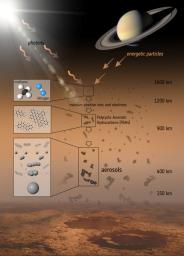
|
The Formation of Titan’s Haze
- Click the image above for a larger view
- Full-Res JPEG (2000 x 2776) (391.3 kB)
- Full-Res TIFF (2000 x 2776) (16.7 MB)
Caption:
This illustration shows the various steps that lead to the formation of the aerosols that make up the haze on Titan, Saturn's largest moon.
When sunlight or highly energetic particles from Saturn's magnetosphere hit the layers of Titan's atmosphere above about 600 miles (1,000 kilometers), the nitrogen and methane molecules there are broken up. This results in the formation of massive positive ions and electrons, which trigger a chain of chemical reactions that produce a variety of hydrocarbons. Many of these hydrocarbons have been detected in Titan's atmosphere, including polycyclic aromatic hydrocarbons (PAHs), which are large carbon-based molecules that form from the aggregation of smaller hydrocarbons. Some of the PAHs detected in the atmosphere of Titan also contain nitrogen atoms.
PAHs are the first step in a sequence of increasingly larger compounds. Models show how PAHs can coagulate and form large aggregates, which tend to sink, due to their greater weight, into the lower atmospheric layers. The higher densities in Titan's lower atmosphere favor the further growth of these large conglomerates of atoms and molecules. These reactions eventually lead to the production of carbon-based aerosols, large aggregates of atoms and molecules that are found in the lower layers of the haze that enshrouds Titan, well below about 300 miles (500 kilometers).
Background Info:
The Cassini-Huygens mission is a cooperative project of NASA, ESA and Italy's ASI space agency. The Jet Propulsion Laboratory manages the Cassini-Huygens mission for NASA's Science Mission Directorate, Washington DC, USA. The visual and infrared mapping spectrometer team is based at the University of Arizona, Tucson. The California Institute of Technology in Pasadena manages JPL for NASA.
Cataloging Keywords:
| Name | Value | Additional Values |
|---|---|---|
| Target | Titan | |
| System | Saturn | |
| Target Type | Satellite | |
| Mission | Cassini-Huygens | |
| Instrument Host | Cassini Orbiter | |
| Host Type | Orbiter | |
| Instrument | ||
| Detector | ||
| Extra Keywords | Atmosphere, Color, Haze, Infrared, Magnetosphere, Methane | |
| Acquisition Date | ||
| Release Date | 2013-06-05 | |
| Date in Caption | ||
| Image Credit | ESA/ATG medialab | |
| Source | photojournal.jpl.nasa.gov/catalog/PIA17240 | |
| Identifier | PIA17240 | |
